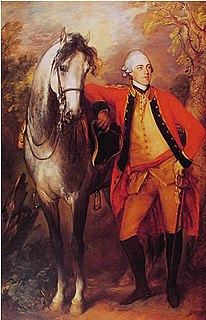
Robert Henley, 1st Earl of Northington, PC, was the Lord High Chancellor of Great Britain. He was a member of the Whig Party in the parliament and was known for his wit and writing.

Marquess of Ailesbury, in the County of Buckingham, is a title in the Peerage of the United Kingdom. It was created on 17 July 1821 for Charles Brudenell-Bruce, 2nd Earl of Ailesbury.

The Dukedom of Albemarle has been created twice in the Peerage of England, each time ending in extinction. Additionally, the title was created a third time by James II in exile and a fourth time by his son the Old Pretender, in the Jacobite Peerage. The name Albemarle is derived from the Latinised form of the French county of Aumale in Normandy, other forms being Aubemarle and Aumerle. It arose in connection with the ancient Norman Counts of Aumale of Aumale in Normandy. See also Earl of Albemarle.

Earl of Gosford is a title in the Peerage of Ireland. It was created in 1806 for Arthur Acheson, 2nd Viscount Gosford.
Viscount Aboyne was a title in the Peerage of Scotland. It was created on 20 April 1632 for George Gordon, Earl of Enzie, eldest son of George Gordon, 1st Marquess of Huntly, with remainder that the title should pass to his second son the Hon. James Gordon on his death or on the death of his father, whichever came first. On Lord Huntly's succession to the marquessate in 1636 the viscountcy passed according to the special remainder to his second son, the second Viscount. He never married and on his death in 1649 the title became extinct.
This is a list of people who have served as Lord-Lieutenant of Wicklow. A lord-lieutenant is the British monarch's personal representative, in this case of County Wicklow, Ireland.
John Butler, known as John Butler of Kilcash, a member of the Irish landed gentry, was de jure15th Earl of Ormonde and 8th Earl of Ossory. He did not assume these titles as he thought them forfeit by the attainder of the 2nd Duke of Ormond. He did, however, inherit the Ormond estate from the 1st Earl of Arran through Arran's sister Amelia. In 1791, the title of Earl of Ormond would be successfully claimed by his cousin, the 17th Earl.

Lieutenant-General Charles Butler, 1st Earl of Arran, de jure3rd Duke of Ormonde (1671–1758) was an Anglo-Irish peer. His uncle Richard was the 1st Earl of Arran of the first creation. The titles were re-created for Charles in 1693. His elder brother, the 2nd Duke of Ormonde, was attainted during the Jacobite rising of 1715, but in 1721 Arran was allowed to buy the estate back. At the death of the 2nd Duke he succeeded as de jure 3rd Duke of Ormonde in the Peerage of Ireland but did not claim the title.

Lieutenant General Edward Ligonier, 1st Earl Ligonier KB was a British soldier and courtier. He was the illegitimate son of Col. Francis Augustus Ligonier, the brother of John Ligonier, 1st Earl Ligonier.

John Stratford, 3rd Earl of Aldborough (–1823) was an Irish peer and member of the House of Stratford. He was known as the Hon. John Stratford until 1801, when he inherited the Earldom from his brother Edward Stratford, 2nd Earl of Aldborough.

Benjamin O'Neale Stratford, 4th Earl of Aldborough styled The Honourable from 1763 until 1823, was an Irish peer and politician of the noble House of Stratford.

John Stratford, 1st Earl of Aldborough was an Irish peer and politician and member of the Noble House of Stratford.

Edward Augustus Stratford, 2nd Earl of Aldborough FRS of Belan house, styled The Honourable from 1763 to 1777 and Viscount Amiens in the latter year, was an Irish peer, Whig politician, and member of the Noble House of Stratford. He sat in the Irish House of Commons between 1759 and 1777 and in the British House of Commons from 1774 to 1775.

Connor O'Brien, 2nd Viscount Clare (1605–1670) was the son of Daniel O'Brien, 1st Viscount Clare and Lady Catherine FitzGerald, a daughter of Gerald, 14th Earl of Desmond.

Wingfield Cromwell, 2nd Earl of Ardglass, DCL, was an English nobleman, son of Thomas Cromwell, 1st Earl of Ardglass and Elizabeth Meverell. He held the subsidiary titles of 2nd Viscount Lecale and 5th Baron Cromwell of Oakham.

Thomas Cromwell, 3rd Earl of Ardglass, was an English nobleman, the only son of Wingfield Cromwell, 2nd Earl of Ardglass of Ilam, Staffordshire and Mary Russell. He held the subsidiary titles of 3rd Viscount Lecale and 6th Baron Cromwell of Oakham.
Theobald Butler, 1st Viscount Butler of Tulleophelim, was an Irish peer.

The House of Stratford is a British aristocratic family, originating in Stratford-on-Avon between the eleventh and thirteenth centuries. The family has produced multiple titles, including Earl of Aldborough, Viscount Amiens, Baron Baltinglass, Viscount Stratford de Redcliffe and the Dugdale Baronets. The Viscount Powerscourt and Baron Wrottesley both claim descent from this House. Historic seats have included Farmcote Manor and Stratford Park in Gloucester, Merevale Hall in Warwickshire, Baltinglass Castle, Belan and Aldborough House in Ireland, and Stratford House in London, amongst many others. The house was at its most powerful in the fourteenth, sixteenth, and eighteenth centuries.
Sir Edward Loftus, 1st Baronet was an Anglo-Irish politician.
Thomas Roper, 1st Viscount Baltinglass was an Anglo-Irish soldier and peer.










